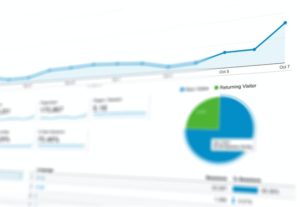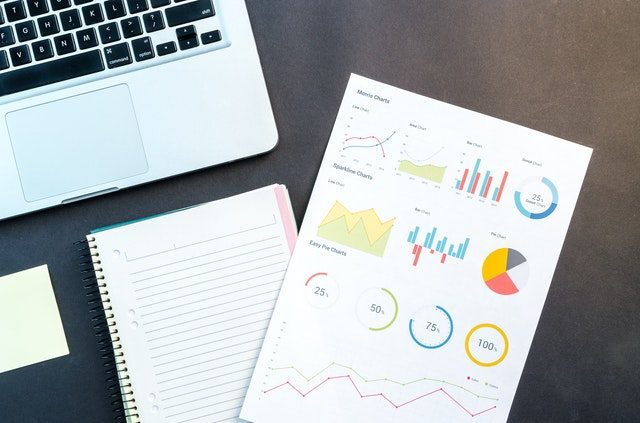Through effective business analytics, organizations uncover patterns and trends underlying their data. Business analytics relies on business acumen, technical skill, and strategic thinking to transform data into valuable insights and those insights into solid decisions. A business analytics Online MBA provides the business training needed for success in this exciting field for professionals possessing this unique blend of aptitudes.

Because we live in a digitally-driven society, it comes as no surprise that every website visit, mobile app usage, and debit card purchase generates data. Globally, human beings produce an overwhelming 2.5 quintillion bytes each day. All that information is a veritable goldmine for corporations and organizations. Businesses have always found it valuable to know who is using their services and buying their products, what influences their purchasing decisions, and how to better retain their business through new strategies and products. For example, by arranging customers by location, age, and shopping history, a company can determine what products and services to offer to improve sales or what campaigns to launch to create brand loyalty.
There was a time when this meant investigating the company sales ledger and predicting the next quarter’s performance based on findings. Today, firms have massive amounts of data to measure, with today’s digital purchases tracked down to the penny and the second. Structured and unstructured data collected by businesses is called Big Data, and it’s as much a corporate asset as its equipment or securities. However, it’s one thing to acquire raw data and another thing to analyze it to generate actionable information. That’s where business analytics thrives.
What is Important to Know about Business Analytics?
Business analytics is an iterative process of systematic gathering and use of data from an organization or business. The method relies heavily on statistical analysis and is performed by entities to influence informed decision-making. Business analytics aids companies in getting insights into their performance, which is quantified as a corporate asset, which helps them gain a competitive edge. Business analytics also helps brands optimize and automate their business processes.
How Business Analytics Works
Business analytics acts as an umbrella covering two distinct business fields: advanced analytics and business intelligence. Both are necessary ways to guide decisions and predict future outcomes.
Business Intelligence involves reviewing historical data to realize how a product line or department within a business has performed over a period. Business Intelligence has existed for years and is a well-established practice. Years ago, when Henry Ford revolutionized manufacturing with the creation of the assembly line, he measured the time his workers spent in each step of the automobile building process and adjusted his procedures accordingly. Examples of business intelligence practices can include querying, reporting, and online analytical processing.
Compared to business intelligence, advanced analytics is a recent development and a specialized practice. It involves deep statistical analysis, like performing predictive analytics through statistical algorithm application to historical data to predict how a new website design or service will affect sales. Since advanced analysis is a specialized field that has reshaped business insights in recent years, organizations rely on skilled professionals with business analytics degrees to carry out operations.
Examples of advanced analytics practices may include:
-Data mining
–Cluster analysis
-Simulation algorithms
Business Analytics is divided into several process types based on their purposes. While there is some distinction in how these fields are viewed, most professionals agree on these categories:

Descriptive Analytics
This practice provides insights gathered from historical data using reporting, scorecards, clustering, etc. Descriptive analytics reports to businesses what is going on in their organization and allows them to observe and measure trends. This type of business analytics seeks to answer the question, “what is happening?” The practice of descriptive analytics often involves segmenting data patterns through “drilling down” and “slicing and dicing.”
Predictive Analytics
This practice creates predictive models through statistical techniques and machine learning. Predictive analytics helps firms project how current trends will play out over time. This type of business analytics answers the question, “what will most likely happen next?” The predictive analytics practice often involves forecasting and data mining.
Prescriptive Analytics
This type of business analytics determines business decisions based on optimization, simulation, etc. Prescriptive analytics aids companies in making critical plans based on potential scenarios gleaned from past and current gathered information. This practice answers the question, “what can we do now?” The process of prescriptive analytics involves operating off risk management and resource reallocation recommendations.
Top Reasons Why Organizations Need Business Analytics
There was a time in history when business analytics was conducted after the fact. Organizations would tally up their sales within a given time and apply the information to forecast sales for a predetermined period in the future. But today, business analytics is used to drive consumer actions in real-time. For example, a brand may use business analytics to alter their product selections available to consumers based on their unique browsing decisions as they shop. This level of customization requires a high degree of specific data and a streamlined way to apply it.
All businesses and organizations want ways to measure their performance as they make informed decisions. But larger corporations that market directly to consumers place particular value on Big Data. Their business decisions involve vast sums of money, slim error margins, constant competition, and a quick turnaround. Organizations like this identify themselves as “data-driven” and place a high premium on making decisions based on solid information. Data-driven corporations make it a point to collect not only high-volume but also high-quality data. They depend on trained professionals with advanced degrees like a Business Analytics Online MBA to help them use it properly.
Business analytics offers organizations valuable competitive advantages, including:
-Expedited answers to business questions
-Solutions grounded in facts instead of guesswork
-Real-time insights into customer behavior
-Cross-selling and up-selling opportunities
-On-demand business metrics reporting
The History of Business Analytics

Business analytics has turned into a buzzword for many companies worldwide today. No matter its size, every business is on the lookout for various ways to make sense of the large amount of raw data available. Business analytics has been transforming the way organizations function for well over two decades. From targeting customers and increasing sales to helping HR representatives select appropriate candidates and reducing overhead costs, there is no business sector where data analytics has failed to influence.
But how did business analytics get its start? Why has the field gained popularity in recent years? How has the way organizations use data evolved? And what did business analytics look like two decades ago? To help find answers to such questions, let’s dive into the history of business analytics by using a timeline that starts during the 1800s and runs to 2020.
Analytics in the 1800s: The desire to Stay Ahead
The use of data to stay ahead of the competition dates back to 1865. That year, Richard Miller Devens explained in a book how banker Sir Henry Furnese continued to be one step ahead by actively documenting information and making business decisions based on it before any of his competitors. For the first time in history, professionals like Sir Furnese started relying more on empirical evidence and data rather than gut instinct.
Analytics in the late 1800s: The Birth of Scientific Management
During this era, Frederick Taylor introduced the inaugural business analytics system in the United States, naming it scientific management. The system aimed to analyze the workers’ body movements and production techniques to identify and determine greater efficiencies.
Analytics in the early 1900s: The Growth of the Manufacturing Industry
Henry Ford further developed Frederick Taylor’s scientific management system after Ford hired Taylor as a consultant. The automobile titan was able to measure the time each component of the Ford Model T took to put into place on his assembly line. This study transformed his corporation’s manufacturing process and the manufacturing industry worldwide.
Analytics in the 1950s: IBM’s First Hard Drive Disk
Computers were virtually inaccessible in the early 1900s, but a massive demand for them occurred during World War II. They were still rudimentary and fundamental in their inception, consisting of tapes or punch cards used to store information. However, in the mid-1950s, tech giant IBM developed the world’s first hard disk drive. Users could now save a vast amount of data with better flexibility.
Analytics in the late 1900s: The Dawn of Business Intelligence

Due to lower storage space prices and improved databases, business intelligence solution’s next generation was primed to step in. There was a high amount of data available by this time in history but no centralized location to store it. To address this issue, Bill Inmon and Ralph Kimball proposed similar plans to construct data warehouses.
Analytics in the year 2000: The Presence of Various Analytical Solutions
At the turn of the century, medium and larger businesses and organizations had realized the vital need for business intelligence solutions. Corporations like Oracle, IBM, Microsoft, and SAP were on the frontlines of developing solutions that would change the way the world does business.
Analytics in 2005: The Peoples’ Access to Data
Considering data’s extensive use, organizations began directing efforts to improve the speed of information’s availability. New business analytics tools were developed to ensure that technical and non-technical people could mine data and gain essential insights. By this time in history, the business world’s increased interconnectivity led to the need for real-time data. Google got to work to provide an accessible and free way for users to analyze website data. Enter Google Analytics.
Analytics from 2005 to Today: An Essential Element for Companies Worldwide
With internet availability a reality to almost everyone on earth and an ever-increasing amount of data available, companies looked for better solutions to analyze and store all the information. Designing computers with more storage capacity and faster speeds proved difficult for some, so companies utilized multiple machines simultaneously. This was the dawn of cloud storage. Over the last ten years, cloud computing, big data, and business analytics have remained integral for virtually all functioning organizations. New advancements in technology have made these systems even better. Today, analytics and data science are viewed as a necessary part of the future. From marketing and advertising to planning operational activities and recruiting, these terms are used in every field of business.
From its advent in the early 1800s to its being an integral part of every business in 2021, analytics has proven itself over time to be needed for organizations wanting to make sound business decisions. Let’s now consider what it takes to pursue an advanced degree in business analytics.
Facts about the Online MBA in Business Analytics

If you possess an analytic mindset, business savvy, and an interest in statistics, you may be a prime candidate for tapping into this in-demand and challenging field. An Online MBA with a concentration in business analytics is the perfect way to launch a business analytics career, particularly for those interested in the applied aspects of the field, including driving business practices via data-driven decision-making.
An Online MBA in business analytics is a distance degree that includes special training in business analytics. When these business students graduate, they are first and foremost business administration professionals with a keen knowledge of data analytics tools and how to use data insights to make solid business decisions. U.S. News and World Report says that an MBA specialization gives business leaders a competitive edge over their peers. Data and tech sectors remain some of the most emerging specialties. A Business Analytics Online MBA is a multidisciplinary program and includes training in technical skills, communication, business fundamentals, leadership, and management practices, in addition to skills specific to business analytics.
What You Can Expect to Learn in a Business Analytics Online MBA
An Online MBA exists to train business leaders, including c-suite executives, and their primary areas of education will be in management and business operations. The Online MBA program provides distance learners with a solid understanding of business fundamentals, including soft and hard business skills. These concepts are delivered through a sequence of required core courses.
Course topics included within the core coursework of an online MBA could consist of:
-Macroeconomics
-Microeconomics
-Accounting
-Operations
-Finance
-Marketing
-Ethics
-International Business
-Management
-Human Resources
-Leadership
A business analytics emphasis dives into specific business data and analytics skills while teaching graduate students to strain business issues through a data-driven filter. They get hands-on practice utilizing the most cutting-edge business analytics tools, work through case studies, and coordinate projects, some of which may include real-world data. Instructors teach business analytics classes with field experience. They deliver real-world advice and insights.
Some classes offered within a business analytics online MBA concentration may include:
-Data Mining
-Spreadsheet Modeling
-Accounting Analytics
-Forecasting and Modeling
-Marketing Analytics
-Financial Analytics
-Business Statistics
-Business Analytics Strategy
-Applied Regression
-Principles of Management Science

Most programs include practicums, internships, and other hands-on learning components in addition to Online MBA core courses and business analytics courses. This allows graduate students to gain real-world experience as they demonstrate to employers that they know how to apply their classroom lessons in the field.
An Online MBA in business analytics usually takes two years to complete. Some business schools allow students to meet all program requirements in six or seven years. Business professions interested in launching new business roles or switching careers are prime candidates for a full-time degree. Mid-career professionals wanting to advance existing careers may wish to study part-time, which may take three years or longer. Accelerated programs are an excellent option for students with a margin of time. This format condenses the same curriculum into a rigorous program of 12-18 months.
Specifics of a Business Analytics Online MBA
Today, many business schools offer Online MBA degrees. A growing number of these schools also feature online emphases in business analytics. These programs’ curriculum, class titles, and instructors tend to be identical to those featured within on-campus schools. Most business schools use the same professors to teach both online and on-campus MBA classes. Online classes offer a few advantages over classes presented in a traditional brick-and-mortar school, especially for business students looking to hold professional positions while completing their degrees. Online courses may include synchronous and asynchronous (on-demand) course content, which allows distance learners to work through their Online MBA in business analytics at the pace of their choice.
Some prospective online students worry about missing out on one of the essential pieces of value traditional graduates have access to within an MBA program – a solid professional network. So many Online MBA programs are delivered within a cohort format. In this structure, students start their coursework simultaneously as a group, progress through the courses at the same pace, and even graduate together. Working alongside each other while remotely collaborating on projects allows the cohort to form a bonded group much like one found in an on-campus MBA class.
Professional Positions Available to Graduates of an Business Analytics Online MBA
With an online MBA in business analytics, distance learners are eligible for a wide range of careers, including attractive c-suite positions. MBAs are qualified for leadership roles in many business settings. Additionally, data-driven decision-making is needed across all types of business, from manufacturing to healthcare, and in every department, from supply chain management to marketing.
Since an Online MBA in analytics is a business degree, graduates won’t pursue strict data science positions. Instead, they are eligible for data-focused business jobs. With a background in analytics, Online MBA students have a unique advantage while competing for more general positions in business management.
Professional positions available to Online MBA in business analytics graduates include:

-Marketing Manager
-Supply Chain Analyst
-Personal Financial Advisor
-Financial Analyst
-Operations Analyst
-Management Analyst
-Management Consultant
-Business Intelligence Analyst
-Business Analytics Specialist
How to Ensure that an Online MBA in Business Analytics is the Right Choice
It’s clear that careers in Big Data are among the most exciting out there, and this guide to a Business Analytics Online MBA proves that this distance degree is an excellent way to land one of these in-demand jobs. But just because the field is hot doesn’t mean it’s the right field for all working professionals. It takes a very particular set of interests and aptitudes to flourish in business analytics. These skills may include:
-Big picture thinking
-Business acumen
-Leadership
-Strategic mindset
-Technological aptitude
-Interest in statistics
-Decision making
Potential MBA students discovering their interests lean to the technical side may be better suited for a degree like the MS in Business Analytics or an MS in Data Science. Students may also discover they are more interested in a general MBA or a degree with a related concentration like Information Technology, Risk Management, or Finance. Professionals with analytical and business strengths will discover that a business analytics concentration may be the perfect fit for their future careers.
Action Plans
1. Create a Learning Plan
Potential business students new to the data analysis world will want to start developing some basic knowledge in the field. Getting an overview of data analytics can help them decide whether the career is a good fit while equipping them with job-ready skills. While professionals can develop foundational knowledge and enhance their resumes with a degree in math, computer science, or related fields, they can also learn concepts through alternative resources like free self-study courses, professional certificate programs, and boot camps.
2. Develop Technical Skills
Landing a job in analytics often requires shaping a set of specific technical skills. This can be done by pursuing a degree or enrolling in a professional certificate program. Essential skills needed to get hired could include:
–Statistics
-Data visualization
-R or Python programming
-SQL (Structured Query Language)
–Data cleaning and preparation
3. Work on Real Data Projects
One of the best ways to find value in data is to work with it through real-world settings. Enroll in a degree program that includes hands-on projects utilizing real data. There is a variety of free public data sets students can use to design their projects. National Centers for Environmental Information climate data, data from BuzzFeed, or access Earth and Beyond with NASA open data are excellent resources.
This guide has been written for potential business students interested in a career in analytics. Pursuing a degree like the Online MBA in business analytics is one of the best ways to ensure a fruitful career in the field.
Related Resources:
Top Online Healthcare MBA Programs
Alternatives to an Online MBA
How Can I take Free Online MBA Courses?
Top Online MBA Programs
Best Marketing MBA Jobs
